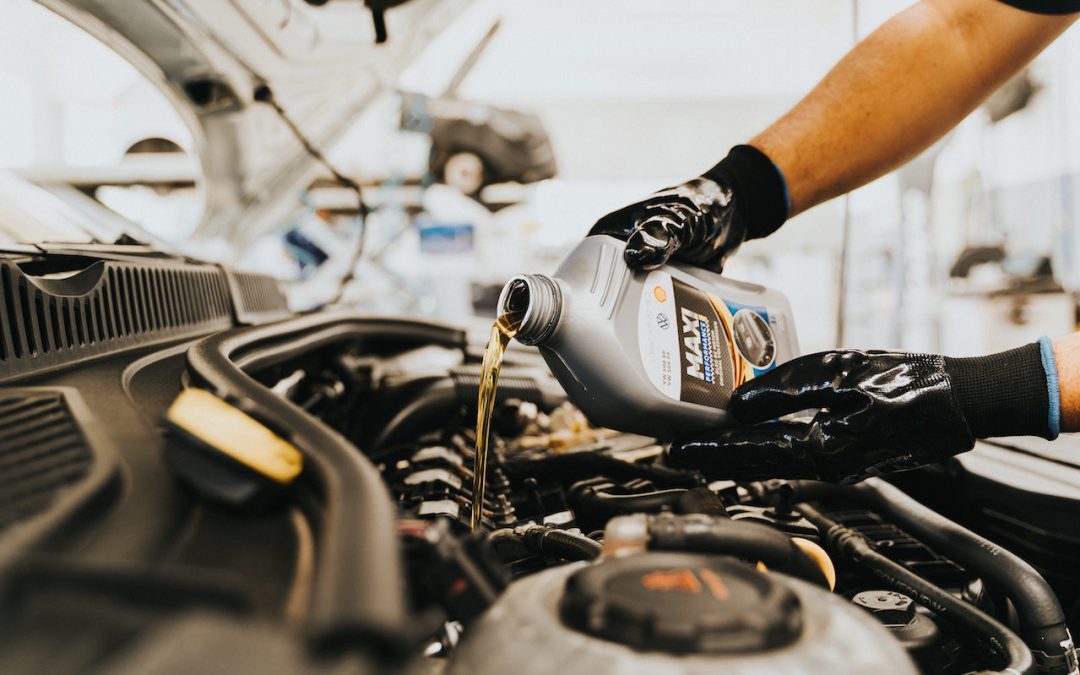To determine if you’re overdue for an oil change, watch out for warning lights on your dashboard, listen for louder engine noise, and examine the oil’s color and level with the dipstick. Most new cars turn their oil dark and thick, or even smell burnt, when they’re overdue. Missing oil changes can make engine parts wear quickly and shorten automobile life. Oil degrades and no longer has the protecting power to keep the engine safe. A lot of car makers recommend changing oil every 8,000 to 12,000 kilometers, but intense usage or rough drives can reduce this time frame. To assist you in catching them in their infancy and protecting your ride, the main body will discuss straightforward tests and typical clues in depth.
Key Takeaways
- Understand the multiple functions of engine oil, such as lubrication, cooling, cleaning, and sealing, that help boost performance and long-term engine health.
- Be aware of overdue oil change symptoms, including dashboard alerts, engine noise, dirty oil, exhaust smoke and burning fumes to avoid extreme, expensive engine damage.
- Know that your driving habits, climate and type of oil have a direct impact on how often your oil should be changed, so tailor your schedule beyond generic sticker prompts.
- Perform quick inspections of your oil via dipstick to check levels, color and texture as these simple checks can give you immediate indicators of oil quality and prevent you from running low or using degraded oil.
- Waiting too long between oil changes can lead to diminished performance, internal engine wear, and potentially catastrophic engine failure. This is the kind of scheduled maintenance that’s important for reliability and safety.
- Listen to your car by paying attention to slight differences in performance, vibrations, or hesitations that may indicate oil problems–early action can help you avoid repair bills and extend the life of your engine.
Why Engine Oil Matters
Engine oil is essential for maintaining a vehicle’s engine at peak performance. It plays behind the scenes to reduce friction, keep things cool, clean out debris, and seal spaces between parts. So, why does engine oil matter? Because over time, oil degrades and loses its ability to shield the engine, which is why timely changes are essential. The following table outlines these primary functions.
|
Function |
Description |
|
Lubrication |
Reduces friction and wear by forming a film between moving parts, allowing smooth operation. |
|
Cooling |
Draws heat away from engine parts, helping keep engine temperature stable and safe. |
|
Cleaning |
Collects and carries away dirt, debris, and metal particles, keeping the engine clean. |
|
Sealing |
Fills small gaps between parts, prevents leaks, and maintains needed pressure in the engine. |
Lubrication
Quality lubrication prevents metal components from chewing on each other.
- Lowers wear and tear on critical engine parts
- Reduces engine noise and smooths out motor operation
- Keeps oil at the right thickness for all temperatures
- If oil gets old or dirty, friction increases and parts can fail.
When the oil is new it holds its flow, or viscosity, so it runs well in the engine. Without sufficient lubrication, the engine struggles, wearing out more quickly and possibly even seizing up completely. That’s why engine oil is so critical to long engine life.
Cooling
Oil absorbs heat from friction-showered parts and distributes it throughout the engine to keep them cool.
As oil circulates, it controls the engine’s temperature — necessary for both short and long journeys. Old oil isn’t able to transport heat as effectively, so engines warm quickly and can overheat. If you skip oil changes, cooling power drops, and repairs can get expensive.
A decline in gas mileage or an increase in engine noise can indicate oil is not keeping the engine cool enough anymore.
Cleaning
Engine oil grabs dirt, soot and metal bits before they can adhere to engine parts, helping maintain cleanliness.
It prevents sludge from accumulating, which can impede oil circulation and damage engine performance. We all know clean oil helps the engine perform better and prolong its life. Having the oil changed when necessary keeps everything running smooth and prevents blockages.
Sealing
Oil seals up microscopic gaps between surfaces and maintains hydraulic pressure.
New oil nourishes gaskets and seals, preventing leaks. Old oil can eat away at these seals, causing leaks and pressure loss. Fresh oil keeps the engine strong.
Key Overdue Oil Change Symptoms
Catching them early prevents engine damage and expensive repairs. Routine inspections provide comfort and keep the motor humming.
Exhaust Smoke
Too much exhaust smoke can signal overdue oil changes or engine troubles. Blue or black smoke typically indicates that oil is burning in the combustion chamber — which can occur if seals fail from old oil. Elevated emissions could indicate that oil isn’t doing its job. Identifying and repairing these problems early can aid in avoiding larger engine complications down the road.
Unusual Smells
The burning smell from under the hood could indicate overheated or leaking oil. Strong oil smells typically indicate the oil is breaking down and not effectively protecting the engine anymore. Odd smells should never be shrugged off, as they can warn of serious engine trouble. Swift action can prevent engine destruction.
Beyond the Sticker Myth
The sticker reminders in your car tend to push a specific oil change interval, but these are typically generic and based on antiquated standards. Most people assume a 4,800-kilometre (3,000-mile) rule applies to every car, however, new innovations in engine design and oil technology have made best practices different. These days, manufacturer guidelines can be anywhere from 8,000km (5,000 miles) to 16,000km (10,000 miles) or more – particularly with synthetic oil. By factoring in your own habits, environment, and vehicle needs, you can establish a more precise oil change schedule and keep your engine going strong.
Your Driving Style
Hard driving — such as rapid acceleration and hard stops — places greater stress on your engine and degrades oil more rapidly. Taking lots of short trips where the engine doesn’t warm up fully is another culprit in rapid oil degradation.
Long highway cruises at consistent speeds are easier on oil. Engines hit and stay at operating temperatures, extending oil life. In city stop and go traffic, which is usually a lot more, it causes more engine wear and dirtier oil over time.
Changing your oil based on how and where you drive — not a dumb sticker — is a smarter way to keep your engine happy.
Your Environment
Being in a car in such a way that it’s really hot or cold, or driving on dusty, unpaved roads, causes the oil to deteriorate more quickly. Dust, moisture and temperature fluctuations cause oil to degrade faster and ransack its protective properties.
Vehicles in extreme temperatures or on gravel roads require more frequent oil changes to keep pace with these stresses.
By being aware of your local environment and adjusting your maintenance schedule, it is needed to keep your engine running well.
Staying Informed
Owner’s manuals have the most precise interval for your car.
Check your manual, not just the sticker.
Pay attention to your car’s needs.
Update your habits as needed.
The Dipstick Inspection
Regular, dipstick inspections remain one of the easiest methods of monitoring your engine’s oil condition regardless of where you ride. This hands-on check is straightforward: just pull out the dipstick, wipe it with a clean, lint-free cloth, reinsert, and read. It provides you real-time feedback on oil level and quality — important metrics in determining if you’re due for an oil change or encounter a deeper problem. Routine dipstick inspections must be a foundational element of every driver’s vehicle maintenance routine — they avoid engine damage, detect contamination early, and promote long-term engine health.
Check Level
Your oil level on the dipstick should always be between the min and max marks. If your reading is under the minimum, you risk under-lubrication—which can cause metal parts to grind, overheat, or even seize. Even a slight dip below the range can increase engine wear over time.
Observing a low oil level is an obvious prompt to fill up right away, but repeated declines could indicate leaks or oil burning. Period inspections allow you to catch these tendencies early before they develop into expensive repairs. Each car is different so always consult your owner’s manual for whether to check oil warm or cold.
Check Texture
Touch the oil between your fingers. Good, clean oil says your engine’s protected. Gritty or sludgy oil indicates dirt, or metal shavings or sludge, that can damage engine surfaces.
Dirty oil typically signifies it’s time for an oil change–or even worse a leaking gasket. Texture checks provide an additional layer of data, assisting you in detecting problems that your eyes alone cannot identify.

The Risks of Delay
Putting off an oil change does more than just postpone a minor chore. As the years pass, old oil disintegrates, loses its protective capabilities for the engine, and can leave vital internal parts at risk of friction, wear, and heat. This endangers the engine’s health and performance, particularly for drivers who encounter demanding conditions, such as stop-and-go traffic, hot or cold weather, short urban trips, or towing heavy loads. Oil changes are a cheap step that can save thousands in repairs and prolong the life of the engine.
Performance Loss
Delayed oil changes cause lackluster gas mileage and sluggishness that you encounter on a daily drive.
- Noticeable drop in fuel economy
- Slow engine response or lack of power
- Engine running hotter than usual
- Odd ticking or knocking noises from under the hood
- Warning lights appearing on the dashboard
Performance loss doesn’t just make driving less fun, it can impact safety as well. Say, for instance, a slow-reacting car in dense traffic or during a pass — that could endanger the driver. Following an oil change schedule helps keep your engine running at its optimum and ensures every ride is smooth and secure.
Engine Damage
Old oil won’t shield engine parts from friction and heat for much longer. As oil sits, it ages, thickens, and sludge up, exposing metal surfaces. This makes pistons, bearings, and other moving parts grind against each other, wearing themselves out from the inside. Repairs from this extent of damage can run into the thousands, or in certain situations, the engine may need to be replaced altogether. Sticking to the proper oil change interval for your vehicle—particularly if it requires ‘severe service’—is critical to preventing this type of damage from getting started.
Total Failure
When oil changes are missed too frequently, parts in an engine can come apart or seize up. Repairs following a catastrophic failure tend to be more than the car is worth, which is why many throw in the towel. Even pushing your oil change interval once beyond the suggested limit may shove an already worn engine over the edge. Proactive maintenance is the best way to sidestep this destiny and safeguard your investment for years.
Listen to Your Car
For drivers who own or depend on a personal vehicle, you should know that listening to your car can help you avoid bigger issues. Uncommon sounds, shaking or performance degradation tend to be early signals related to oil quality or level. Catching these specifics is all part of shrewd, diligent auto maintenance—particularly when oil change resets can be between 8,000 and 24,000 kilometers depending on the car and grade of motor oil. Listening to your car, literally, allows you to hear subtle indicators before a minor problem escalates into engine trouble.
Subtle Vibrations
Strange driving vibrations may be the symptom of impending engine trouble. If you feel shudders or shaking that weren’t there previously, particularly as you idle or accelerate, this could indicate the engine isn’t receiving adequate lubrication. That’s frequently due to old or dirty oil, no longer capable of performing its function.
Vibrations can indicate early engine wear or deterioration of key oil characteristics. For instance, if oil has become sludge, moving parts begin to grind or knock, sending small but perceptible shudders throughout the car. Neglecting these vibrations can result in costly repairs down the road, so inspect the oil or take it to a mechanic the moment you notice a change. One quick test is to inspect your vehicle’s dip stick for dark or gritty oil, an easy way to confirm if maintenance is overdue.
Hesitation
Hesitation on acceleration is closely related to oil quality. Watch for:
- Delayed response when pressing the accelerator
- Brief stalling or lurching forward
- Engine struggling to reach higher speeds
- Loss of smoothness during gear shifts
These could be indicators of oil that no longer shields engine components. Tending to them swiftly can help keep driving safer and more consistent. A routine oil change schedule keeps the engine humming, which is critical for anyone who depends on their car every day.
Performance Shifts
A loss of power, slow acceleration, or increased crank time can all mean the oil isn’t shielding the engine anymore. Degraded or contaminated oil can make the engine labor, diminishing its efficiency and responsiveness.
When oil breaks down, heat and friction go up. You may detect a burnt smell or strange ticking noises from the engine. These aren’t problems to overlook, as they indicate oil that can’t work. Establishing an oil change interval, particularly with synthetic lubricants, sidesteps these issues and maintains your car’s best health.
Conclusion
To check if you’re due for an oil change, listen to the data—be on the lookout for warning lights, grinding noises or decreased engine performance. Experience the way your car drives. Observe the oil color on the dipstick. Sniff for burnt oil. These babies speak the truth better than a sticker in the window. Cars require genuine care, not guesswork or habit. Fresh oil protects all of those moving parts and keeps them slick. Repair minor issues before they get big. Save on future repairs. Pay attention to these signs, check your oil – listen to your car. Post your own oil change tips or tales below! Let the herd teach one another and ride easier.
Frequently Asked Questions
1. How often should engine oil be changed?
Consult your vehicle’s manual for precise intervals. The majority of engines require an oil change once every 8,000–12,000 km. Routine care guards your engine and lengthens its lifespan.
2. What are common signs I need an oil change?
Warning lights, dark or gritty oil, noisy engines, or increased exhaust smoke mean it’s time for an oil change. Ignoring these can wreck your engine.
3. Can I rely on the oil change sticker alone?
No, stickers are merely reminders. Always check your oil’s condition and follow your vehicle manual. Your driving conditions can impact oil life.
4. How do I check oil condition with a dipstick?
Park on a flat surface. Remove the dipstick, wipe it clean, replace and remove again. Inspect oil color and level. If the oil looks dark and dirty, then you’re due for a change.
5. What happens if I delay an oil change?
If you put off oil changes, it can lead to engine wear, overheating, poor performance, or even engine failure. Oil changes on time can save you big money on repairs.
6. Does engine noise mean I need an oil change?
Yes, weird engine noise can mean low or dirty oil. If your engine seems louder than normal, check your oil immediately.
7. Is synthetic oil better than regular oil?
Synthetic oil generally lasts longer and protects better in extreme temperatures. Consult your vehicle’s manual for the appropriate oil.
Time for an Oil Change? Let’s Make It Count.
Don’t let something as simple as old oil turn into a big repair bill. At autoTECH Blackhawk, we don’t just do oil changes — we protect your engine, extend the life of your vehicle, and treat you like family every mile of the way.
Whether your dashboard reminder is flashing or you’re just not sure when your last oil change was, we’ve got you. Our expert techs use only manufacturer-recommended oil and filters, and every service is backed by our industry-leading 3-year/36,000-mile warranty.
Need conventional or synthetic? We’ll help you choose what’s best for your car — and your driving style.
Fast. Friendly. Reliable.
Schedule your contactless oil change today and see why drivers across the Bay Area trust autoTECH Blackhawk to keep their engines running strong.
Book now at AutoTECH Blackhawk or give us a call — let’s keep you moving, worry-free.


